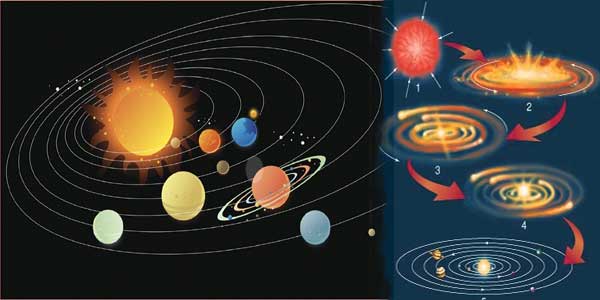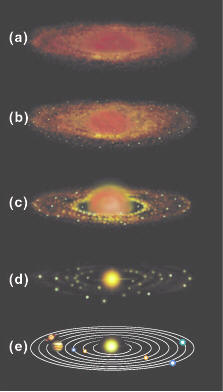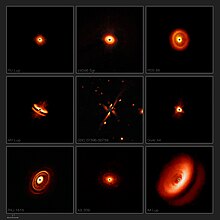Solar Nebula Theory Definition
Our solar system evolved from a contracting nebula. Currently the best theory is the Nebular Theory.
What is accretion theory.

Solar nebula theory definition. It is the most widely accepted model also known as the solar nebular hypothesis The nebular theory describes the formation of the sun planets moons and asteroids around 45 billion years ago from a nebula cloud comprising dust and gas according to Universe. A nebula is a giant cloud of dust and gas in space. The solar nebular theory explains the formation and evolution of the solar system.
Shock waves from a nearby supernova explosion 4. By flying out beyond the interfering influences of Earths magnetic fields the spacecraft can collect samples of the solar wind revealing the makeup of the cloud that formed the solar system nearly 5 billion years ago. Solar Nebula is the cloud of gas and dust that began to collapse about 5 billion years ago to form the solar system.
Cloud formed after a star explodes. Answer 1 of 4. The solar nebula is a sphere of gases and dust from which the planets of the solar system were originated.
It also begins to flatten 5. The theory in this form is not. This states that the solar system developed out of an interstellar cloud of dust and gas called a nebula.
Accretion is the gradual increase in size by the buildup of matter due to gravity. 1Theory that states the solar system began as a huge cloud of dust and gas which later condensed to form the sun and planets 2. Swedish philosopher Emanuel Swedenborg in 1734 proposed that the planets formed out of a nebular.
Heating spinning and flattening. The theory that the planet s formed from the same cloud of gas and dust that formed the sun. What is the nebular theory of solar system formation.
The solar nebula theory also known as the planetesimal hypo thesis or condensation theory describes the solar system as the natural result of the operation of the various laws of physics. This is the rationale of the Genesis mission. Solar nebula The swirling gas surrounding the early Sun during the epoch of solar system formation also referred to as the primitive solar system.
Solar nebula theory - definition of. Some nebulae more than one nebula come from the gas and dust thrown out by the explosion of a dying star such as a supernova. Under the influence of its own gravity the nebula contracts.
Solar nebula gaseous cloud from which in the so-called nebular hypothesis of the origin of the solar system the Sun and planets formed by condensation. A nebula is a cloud in deep space consisting of gas or dirtdust eg. The fact that the planets with the exception of Pluto which is no longer considered a planet all lie in more or less the same plane and the fact that they all orbit the Sun in the same direction suggest that they originated in a disk surrounding the Sun.
Development of Nebular Hypothesis The Nebular hypothesis was developed by a German Philosopher and one. This states that the solar system developed out of an interstellar cloud of dust and gas called a nebula. The solar nebula is the cloud of gas from which our solar system was born when it collapsed under its own gravity.
As the sun cooled it contracted rotated faster and thus caused a ringlike bulging at the equator. The solar nebula took the form of a spinning disk instead of a sphere because of three main processes. Laplace further theorized that the sun and other stars formed from clouds of nebulous matter.
This theory best accounts for the objects we currently find in the Solar System and the distribution of these objectsThe Nebular Theory would have started with a cloud of gas and dust most likely left over from a previous supernova. Immanuel Kant in 1755. Nebula protosun forming spinning planetary disk protoplanets forming moons forming solar system 3.
The theory was first. Other nebulae are regions where new stars are beginning to form. This bulge eventually broke off and formed the planets.
Solar nebula is a gaseous cloud from which in the purported nebular hypothesis of the source of the solar system the Sun is formed by condensation. It is believed that. By re-creating conditions in the solar nebula the swirl of gas that coalesced to form our star the planets and the remnant rocky debris that circles the Sun as asteroids the researchers demonstrated that a simple chemical reaction governed by known physical principles can generate silicate dust with oxygen anomalies that match those found in the oldest rocks in the solar system.
This wind is a snapshot of the materials in the surface layers of the Sun which in turn reflects the makeup of the original solar nebula. Currently the best theory is the Nebular Theory. The solar nebular hypothesis describes the formation of our solar system from a nebula cloud made from a collection of dust and gas.
This effect is known as conservation of angular momentum. The solar nebula theory accounts for a number of key features of our solar system. Its explained by nebular theory which describes the forces and processes at play as a nebula spins and accretes into a star and its planets orbiting it.
A hypothesis concerning the formation of stars and planets and therefore the origin of the solar system according to which a rotating nebula underwent. A theory proposed in 1796 by Laplace supposing that the planets originated from the solar nebula surrounding the proto-sun. According to the Nebular Hypothesis our solar system formed from material in a large nebula.
This theory best accounts for the objects we currently find in the Solar System and the distribution of these objects. Our solar system formed about 46 billion years ago. The Nebular Hypothesis 1 is currently the most widely accepted hypothesis that explains the origins of our solar system and possibly other planetary systems too.
Pictures shown on the left are false color HST images of young stellar systems being revealed by the ionizing radiation of the luminous neighboring young stars in Orion Nebula When the solar system is finally formed and dust has cleared remnants of the formation process and outlying material in the solar systems such as Kuiper belt objects and Oort clouds can be found surrounding the systems. There are many scientific and philosophical theories about the Evolution of the solar system They are about twenty theory Those theories are still unproved and subjected to change. Solar nebula theory synonyms Solar nebula theory pronunciation Solar nebula theory translation English dictionary definition of Solar nebula theory.
As it contracts it spins faster and faster much like an ice skater who pulls in her arms. Solar Nebula Theory The theory that the planet s formed from the same cloud of gas and dust that formed the sun.

How Was The Solar System Formed The Nebular Hypothesis Universe Today

Ess Vocabulary Chapter 22 Touring Our Solar System Flashcards Quizlet

Solar Nebula Theory Hypothesis On The Formation Of The Solar System

How Was The Solar System Formed The Nebular Hypothesis Universe Today

What Are The Six Stages Of The Nebular Theory Study Com

The Solar Nebula Theory Formation Of The Solar System Video Lesson Transcript Study Com
The Solar Nebula Theory Formation Of The Solar System Video Lesson Transcript Study Com

Solar Nebula An Overview Sciencedirect Topics

Evolution Of The Solar System And Stages Of Solar Nebular Theory Science Online

25 5 Any Theory About The Origin Of The Solar System Must Explain Why All Of The Planets Orbits Lie More Or Less In A Plane Why All Of The Planets Orbit

Nebular Theory And The Formation Of The Solar System Historical Geology








0 Response to "Solar Nebula Theory Definition"
Post a Comment